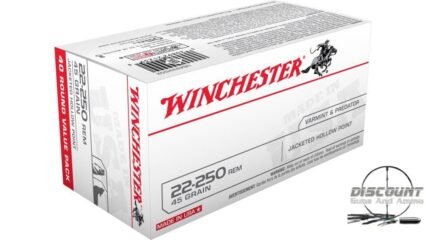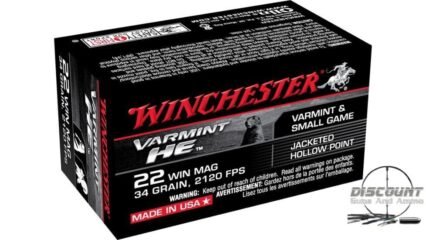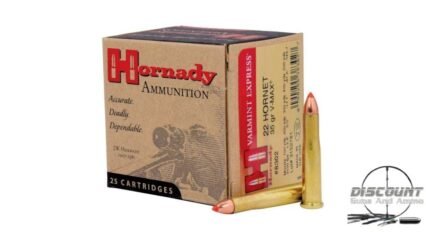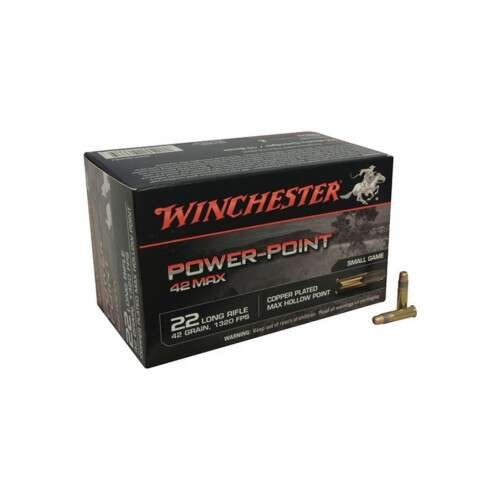Winchester Power point 22lr 42 Max Rimfire ammunition features a unique 42 grain Power-Point truncated nose hollow point bullet perfect for small game. Power-Point bullets have become known as the go-to bullet for hunters seeking accuracy, lethality and proven performance. This 42 grain bullet produces superior expansion compared to other rimfire bullets resulting in outstanding terminal performance.
THIS
WINCHESTER .22 LR AMMUNITION FEATURES THE POWER POINT HOLLOW POINT PROJECTILE FOR IMPROVED BALLISTICS AND OPTIMAL EXPANSION. THE CARTRIDGES UTILIZE A 42-GRAIN BULLET CAPABLE OF TRAVELING AT 1320 FPS, GIVING THEM 162 FT/LBS OF ENERGY AT THE MUZZLE. THIS
AMMUNITION IS GREAT FOR TARGET PRACTICE, RANGE USE AND SMALL-GAME HUNTING
PRODUCT AND COMPANY IDENTIFICATION
Product Name: RIMFIRE/CENTERFIRE PRIMED SHELLCASES
Chemical Name: Mixture
Synonyms: Centerfire Primed Brass, Centerfire Primed Shellcase,
Centerfire Rifle Primed Case, Centerfire Pistol
Primed Case,
Centerfire Rifle Primed Shellcase, Centerfire Pistol Primed Shellcase, Centerfire Rifle
Primed Brass, Centerfire Pistol Primed Brass, CFR Primed Case, CFP Primed Case,CFR Primed
Shellcase, CFP Primed Shellcase, CFR Primed Brass, CFP Primed Brass
Rimfire Primed Brass, Rimfire Primed Shellcase, Rimfire Rifle Primed Case, Rimfire Pistol Primed
Case,
Rimfire Rifle Primed Shellcase, Rimfire Pistol Primed Shellcase, Rimfire Rifle Primed Brass,
Rimfire Pistol Primed Brass, RF Primed Case, RF Primed Shellcase, RF Primed Brass, PSC (Primed
Shellcase), EPC (Empty Primed Case)
Chemical Family: Mixture
Formula: Not applicable – mixture
Product Use/ Description: Primed shellcases for ammunition or powertool loads
COMPANY ADDRESS MSDS Control Group
Olin Corporation – Winchester
Division, Inc.
600 Powder Mill Road
East Alton, IL 62024
www.winchester.com
TECHNICAL
INFORMATION:
618-258-3507
EMERGENCY TELEPHONE NUMBER:
US/Canada: 1-800-424-9300
Outside US/Canada: 703-527-3887
Customer #: ccn24728
2. COMPOSITION / INFORMATION ON INGREDIENTS
Consists of the following 2 components: A) Shellcase; and B) Primer – can be either Centerfire Primer or Rimfire Primer
All percent compositions specified below are based on the entire product.
CAS Number Components % By Weight EINECS/ ELINCS # EU Classification
Symbol R-Phrase
7440-50-8 Copper 55 – 94 231-159-6 None None
7440-66-6 Zinc 3 – 38 231-175-3 F (as dust or
powder)
R 15-17
7439-89-6 Iron 0-97 231-096-4 None None
For Centerfire Primer
15245-44-0 Normal Lead
styphnate
4 – 6 239-290-0 E, T, N R61-3-20/22-33
50/53-62
10022-31-8 Barium nitrate 3.5 – 4.5 233-020-5 O* R8
1345-04-6 Antimony sulfide 1.5 – 2.5 215-713-4 None None
592-87-0 Lead thiocyanate 0.1 – 0.6
For Rimfire Primer
15245-44-0 Normal Lead
styphnate
1.2 – 2.4 239-290-0 E, T, N R61-3-20/22-33
50/53-62
10022-31-8 Barium nitrate 1.1 – 2.7 233-020-5 O* R8
65997-17-3 Fibrous glass
dust
0.9 – 2 266-046-0 None None
*This material is not listed in Annex 1 of Directive 88/379/EEC. Olin has classified the material according to the conventional method based
upon information from similar materials.
OSHA REGULATORY STATUS: Explosive
3. HAZARDS IDENTIFICATION
Page 2 of 6
CAUTION!
EXPLOSIVE. KEEP AWAY FROM HEAT. DO NOT SUBJECT TO MECHANICAL SHOCK. PARTICLES FROM FIRING MAY BE
HARMFUL IF INHALED. DO NOT TAKE INTERNALLY.
HAZARD RATINGS (for dust or fume)
Hazardous Materials Identification System (HMIS)
National Fire Protection Association (NFPA)
HUMAN THRESHOLD RESPONSE DATA
Odor Threshold:
Irritation Threshold:
Degree of hazard (0 = low, 4 = extreme)
Health: 0
Mixture. Not rated.
Unknown
Unknown
Immediately Dangerous to Life or Health (IDLH) Value(s):
Flammability: 2
Physical Hazard:
Explosive: 2
The IDLH for this product is not known. The IDLH for copper and lead
is 100 mg/m3. The IDLH for barium nitrate is 50 mg/m3.
POTENTIAL HEALTH EFFECTS
This product is composed of a metal capsule which contains the various components completely sealed within. Therefore, under
normal handling of this product, no exposure to any harmful materials will occur.
When the product is fired, a small amount of particles may be generated which may be slightly irritating to the eyes and the
respiratory tract. The particles may contain trace amounts of these harmful substances:
Lead: Ingestion of large amounts of lead can cause abdominal pain, constipation, cramps, nausea and/or vomiting. Chronic
exposure to lead can cause kidney damage, anemia, reproductive effects, developmental effects and permanent nervous system
damage in humans including changes in cognitive function.
Copper: Inhalation of high concentrations of metallic copper dusts or fumes may cause nasal irritation and/or nausea, vomiting and
stomach pain.
Antimony sulfide: Inhalation of high concentrations may cause dizziness, headache and nausea. Workers chronically exposed to
high concentrations of antimony sulfide have developed heart and blood effects.
Barium nitrate: Ingestion of large doses of soluble barium compounds can cause cyanosis, skeletal muscle paralysis, respiratory
arrest, irregular heartbeat and hypertension.
It is unlikely that the amount of particles that someone would be exposed to from firing would be sufficient to cause any of these
effects.
MEDICAL CONDITIONS AGGRAVATED BY EXPOSURE: There are no medical conditions known to be aggravated by exposure to
this product in its solid form. Exposure to lead can aggravate anemia, cardiovascular and respiratory disease.
POTENTIAL ENVIRONMENTAL EFFECTS:
4.
FIRST AID MEASURES
Product has not been tested for environmental properties.
EYE CONTACT: Immediately flush out fume or particles with large amounts of water for at least 15 minutes, occasionally lifting
the upper and lower eyelids. If eye irritation develops, call a physician at once.
SKIN CONTACT: Wash skin with plenty of soap and water.
INHALATION:
Get medical attention.
If symptoms of lung irritation occur (coughing, wheezing or breathing difficulty), remove from exposure area to
fresh air immediately. If breathing has stopped, perform artificial respiration. Keep affected person warm and at
rest.
INGESTION:
5.
If ingested, immediately call a physician.
FIRE FIGHTING MEASURES
PROPERTY VALUE PROPERTY VALUE
Explosive Yes
Combustible Not applicable
Flash Point (C): Not applicable
Lower Explosive Limit: Not applicable
Flammable Not applicable
Pyrophoric No
Burning Rate of Material: Not applicable
Autoignition Temp.: No data
Upper Explosive Limit: Not applicable Flammability Classification: (defined by 29 CFR 1910.1200) Explosive
UNUSUAL FIRE AND EXPLOSION HAZARDS: If fire reaches cargo, do not fight. Evacuate all person, including emergency
responders from the area for 1500 feet (1/3 mile) in all directions.
MSDS No.: 00071.0001
Page 3 of 6
MSDS No.: 00071.0001
EXTINGUISHING MEDIA: Flood area with water. If no water is available, carbon dioxide, dry chemical or
earth may be used. If the fire reaches the cargo, withdraw and let fire burn.
SPECIAL FIREFIGHTING PROCEDURES: In case of fire, use normal fire fighting equipment. Protection concerns must also
address the potential of the physical characteristic of this product as explosive.
6. ACCIDENTAL RELEASE MEASURES
FOR ALL TRANSPORTATION ACCIDENTS, CALL CHEMTREC AT 800-424-9300.
Spills of this material should be handled carefully. Do not subject materials to mechanical shock. A spill of this material will normally
not require emergency response team capabilities. If, however, a large spill occurs, call 1-888-289-1911 for technical assistance.
7. HANDLING AND STORAGE
HANDLING: No special requirements
STORAGE: No special requirements
Shelf Life Limitations: Not known
Incompatible Materials for Packaging: None known
Incompatible Materials for Storage or Transport: Acids, Class A & B explosives, strong oxidizers, and caustics
CONDITIONS TO AVOID: Mechanical impact or shock and electrical discharge.
8. EXPOSURE CONTROLS/PERSONAL PROTECTION
CAS # CHEMICAL
NAME
ACGIH TLV OSHA PEL INTERNATIONAL OELS
7440-50-8 Copper 0.2 mg/m3 (fume), 1
mg/m3 (dusts and
mists)
0.1 mg/m3 (fume)
1 mg/m3 (dusts and
mists)
Austria, Belgium, Canada: 0.2 mg/m3 (fumes), 1
mg/m3 (dusts)
Denmark: 1.0 mg/m3 (dust and powder)
Germany (MAK): 0.1 mg/m3 (fume), 1 mg/m3 (dusts
and mists)
7440-66-6 Zinc None established None established None established
7439-89-6 Iron None established None established None established
15245-44-0 Normal Lead
styphnate
None established None established None established
592-87-0 Lead
thiocyanate
None established None established None established
10022-31-8 Barium nitrate 0.5 mg/m3 0.5 mg/m3 Germany (MAK): 0.5 mg/m3 (I), Peak = II (2)
Austria, Belgium, Denmark, Finland, Hungary,
Netherlands, Poland, Switzerland, U.K.: 0.5 mg/m3
1345-04-6 Antimony
sulfide
0.5 mg/m3 0.5 mg/m3 Austria, Belgium, Denmark, France, Finland,
Germany, Hungary, Netherlands, Norway, Poland,
Sweden, UK: 0.5 mg/m3
65997-17-3 Fibrous glass
dust*
10 mg/m3 (particulate) 15 mg/m3 Germany – MAK= 2
Netherlands: 10 mg/m3 MAC (dust)
*This substance is regulated by OSHA as a Particulate Not Otherwise Regulated (PNOR). The exposure limits listed for both OSHA and ACGIH refer to
total dust; the OSHA PEL for the respirable fraction is 5 mg/m3.
ENGINEERING CONTROLS: Local exhaust ventilation is recommended if significant dusting occurs or fumes are generated.
Otherwise, use general exhaust ventilation. Use explosion-proof ventilation.
EYE / FACE PROTECTION: Use safety glasses.
SKIN PROTECTION: Not normally needed
RESPIRATORY PROTECTION: Respiratory protection not normally needed.
GENERAL HYGIENE: Do not eat, drink, or smoke while using this product. Wash hands thoroughly after use.
9. PHYSICAL AND CHEMICAL PROPERTIES
PROPERTY VALUE PROPERTY VALUE
Appearance: Red/gold metallic color
(non-plated); silver colored
(nickel plated) shellcase
Vapor Density (air = 1): Not applicable
Odor: None Boiling Point (F): Not applicable
Molecular Weight: Not applicable – Mixture Melting point: Not applicable
Physical State: Solid Specific gravity (g/cc): Not applicable
pH: Not applicable Bulk Density Not applicable
Page 4 of 6
PROPERTY VALUE
Vapor Pressure (mm Hg): Not applicable
PROPERTY VALUE
Viscosity (cps): Not applicable
Vapor Density Not applicable
Solubility in Water (20 C): Insoluble
Volatiles, Percent by volume: Not applicable
Decomposition Temperature: Unknown
Evaporation Rate: Not applicable
Octanol/water partition coefficient: Not applicable
10.
STABILITY AND REACTIVITY
STABILITY:
MATERIALS TO AVOID:
HAZARDOUS DECOMPOSITION PRODUCTS:
HAZARDOUS POLYMERIZATION:
OTHER:
11.
TOXICOLOGICAL INFORMATION
Stable under normal temperatures and pressure.
Acids, Class A & B explosives, strong oxidizers, and caustics
Nitrogen oxides, carbon monoxide, lead oxides, carbon dioxide, lead
dust/fume
Will not occur.
Subject to mechanical shock or friction
POTENTIAL EXPOSURE ROUTES: The physical nature of this product makes absorption from any route unlikely. A small amount of
inhalable particles may be created when projectile is fired.
ACUTE ANIMAL TOXICITY DATA:
For Product:
For Components
Copper
Iron
Antimony
sulfide
Oral LD50
Not applicable for
product
3.5 mg/kg
(mouse,
intraperitoneal
)
30 g/kg
(rat)
209 mg/kg
(mouse, i.p.)
Fibrous
glass
No data
Zinc Lead
thiocyanate
No
data
Lead
styphnate
No data
Barium
nitrate
No data
Dermal
LD50
Not applicable for
product
375 mg/kg
(rabbit,
subcutaneous)
No data
355 mg/kg
(rat)
>139 mg/kg
(subcutaneo
us)
Inhalation
LC50
Not applicable for
product. Particles
generated from
firing may be
slightly toxic.
No data
No data
No data
No data
No
data
No data
No data
No data
>20
mg/kg
(mouse,
intratrac
heal)
Irritation
Not a skin or eye
irritant as a solid
Respiratory
irritant
Eye irritant
Eye, skin and
respiratory
irritant
No
data
No data
No data
No data
Eye,
skin,
and
respirat
ory
irritant
SUBCHRONIC/ CHRONIC TOXICITY:
Eye
irritant
No data
No data
Eye and skin
irritant
Lead has caused blood, kidney and nervous system damage in laboratory animals.
Laboratory animals repeatedly exposed to antimony sulfide by inhalation developed
degenerative liver and kidney effects.
CARCINOGENICITY:
MUTAGENICITY:
REPRODUCTIVE, TERATOGENICITY, OR
DEVELOPMENTAL EFFECTS:
NEUROLOGICAL EFFECTS:
INTERACTIONS WITH OTHER CHEMICALS
WHICH ENHANCE TOXICITY:
12.
ECOLOGICAL INFORMATION
MSDS No.: 00071.0001
The International Agency for Research on Cancer (IARC) lists lead as possibly
carcinogenic to humans, group 2B. Implantation or injection of man-made glass
fibers into laboratory animals has resulted in the formation of tumors. However,
these studies bypass the animals natural defense mechanisms and are not
necessarily representative of the response in human exposures. IARC lists fibrous
glass as possibly carcinogenic to humans, group 2B.
This product is not known or reported to be mutagenic. Lead has been shown to be
mutagenic in several in vitro assays.
This product is not known or reported to cause reproductive or developmental
effects. Lead has been shown to affect fetal development including birth defects
and reduce male reproductive function in laboratory animals.
This product is not known or reported to cause neurological effects. Lead has
caused peripheral and central nervous system damage and behavioral effects in
laboratory animals.
None known or reported.
Page 5 of 6
MSDS No.: 00071.0001
ECOTOXICITY: No data is available on this product. Individual constituents are as follows:
Copper: The toxicity of copper to aquatic organisms varies significantly not only with the species, but also with the
physical and chemical characteristics of the water, such as its temperature, hardness, turbidity and carbon dioxide
content. Copper concentration varying from 0.1 to 1.0 mg/l have been found by various investigators to be not toxic
for most fish. However, concentrations of 0.015 to 3.0 mg/l have been reported as toxic, particularly in soft water to
many kinds of fish, crustacea, mollusks, insects, and plankton.
Lead: LC 50 (48 hrs.) to bluegill (Lepomis macrochirus) is reported to be 2-5 mg/l. Lead is toxic to waterfowl.
Zinc: The following concentrations of zinc have been reported as lethal to fish:
Rainbow trout fingerlings: 0.13 mg/l, 12 – 24 hours
Bluegill sunfish: 6 hr TLM = 1.9 – 3.6 mg/l (soft water, 30°C)
Rainbow trout: 4 mg/l (hard water) 3 days
Sticklebacks: 1 mg/l (soft water) 24 hrs
The presence of copper appears to have a synergistic effect on the toxicity of zinc towards fish.
MOBILITY: Dissolved lead may migrate through soil.
PERSISTANCE/DEGRADABILITY: Not biodegradable. May decompose in soil leading to accumulation of lead.
BIOACCUMULATION: No data
13. DISPOSAL CONSIDERATIONS
Care must be taken to prevent environmental contamination from the use of this material. The user of this material has the
responsibility to dispose of unused material, residues and containers in compliance with all relevant local, state and federal laws and
regulations regarding treatment, storage and disposal for hazardous and nonhazardous wastes.
14. TRANSPORT INFORMATION
U.S. DOT RID/ADR IMDG IATA IMO Canada TDG
PROPER SHIPPING NAME: Not regulated
for domestic
U.S. transport
Cases, Cartridges, Empty With Primer
HAZARD CLASS: 1.4S
UN NO.: UN0055
PACKING GROUP: II
HAZARD LABEL/PLACARD:
1.4S / 1.4 Placard over 1001 lbs. (454 kg)
REPORTABLE QUANTITY: Not applicable
SPECIAL COMMENTS: Air: (25 Kg. Passenger / 100 Kg. Cargo Per Package)
15. REGULATORY INFORMATION
US FEDERAL
TSCA The components of this product are listed on the Toxic Substance Control Act inventory.
CERCLA: Copper, R.Q.= 5000 lbs.; Zinc, R.Q. = 1000 lbs.; Antimony compounds, R.Q = 5000 lbs. (No reporting
is required if diameter of the pieces of metal is equal to or exceeds 100 micrometers (0.004 inches).
SARA 313: Copper, Lead and Lead compounds, Zinc (fume or dust) Barium compounds, Antimony compounds
SARA 313 Hazard Class: Health: Acute – No
Chronic – No
Fire: No Reactivity: None Release of Pressure: Yes
SARA 302 EHS List: None of the components of this product are listed.
*RQ = Reportable Quantity
STATE RIGHT-TO-KNOW STATUS
Component *CA Prop. 65 New Jersey Pennsylvania Massachusetts Michigan
Copper Not listed X X X X
Zinc Not listed X Not listed X X
Iron Not Listed Not listed Not listed X X
Lead styphnate X Not listed Not listed X Not listed
Lead thiocyanate X Not listed Not listed Not listed Not listed
Barium nitrate Not listed Not listed X X Not listed
Antimony sulfide Not listed Not listed Not listed Not listed Not listed
Fibrous glass X Not listed Not listed Not listed Not listed
Page 6 of 6
* “WARNING: This product contains detectable amounts of a chemical(s) known to the State of California to cause cancer and/or birth defects or other
reproductive harm.”
EUROPEAN REGULATIONS
Hazard Classification
Danger Symbol:
Risk Phrases:
Safety Phrases:
E
R2
S2
Explosive
Risk of explosion by shock, friction, fire or other sources of ignition
Keep out of reach of children.
German WGK Classification: Not known
CANADIAN REGULATIONS
DSL LIST:
IDL:
WHMIS:
16.
The components of this product are on the DSL or are exempt from reporting under the New Substances Notification
Regulations.
Copper, Barium nitrate, Antimony compounds
This product is not subject to WHMIS. It is regulated as a Class 6 Explosive in Canada.
OTHER INFORMATION
REVISIONS:
New International format, toxicology review – 1/1/03; 7/1/09 – changed emergency contact number and mailing
address; 1/1/11 – review; 1/1/12 review; 3/20/12 – Updated Emergency Contact Number; 1/1/13 – review
PREPARED BY: Olin Corporation
OTHER:
Additional information available from: www.winchester.com
NOTICE: THE INFORMATION IN THIS MSDS SHOULD BE PROVIDED TO ALL WHO WILL USE, HANDLE, STORE, TRANSPORT,
OR OTHERWISE BE EXPOSED TO THIS PRODUCT. THIS INFORMATION HAS BEEN PREPARED FOR THE GUIDANCE OF
PLANT ENGINEERING, OPERATIONS AND MANAGEMENT AND FOR PERSONS WORKING WITH OR HANDLING THIS
PRODUCT. OLIN BELIEVES THIS INFORMATION TO BE RELIABLE AND CURRENT AS OF THE DATE OF PUBLICATION, BUT
MAKES NO WARRANTY THAT IT IS.






